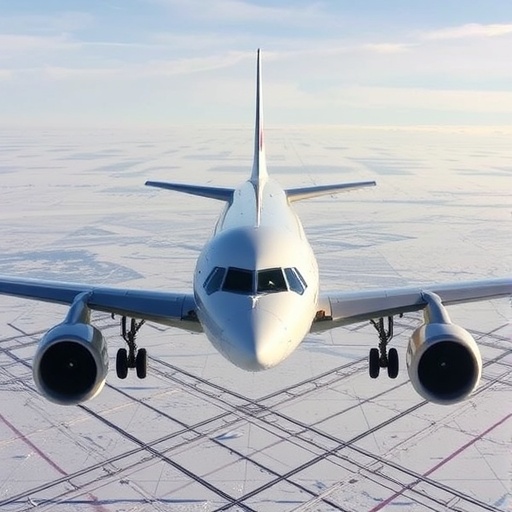In the realm of aviation, the critical challenge posed by icing during flight has long been a concern for aircraft designers and operators alike. As planes ascend into colder atmospheres, conditions can quickly shift from clear skies to treacherous icing environments, presenting significant risks to both safety and performance. The traditional approaches to managing these challenges have primarily involved the integration of de-icing systems and redesigned airfoil shapes that maintain functionality during adverse weather. However, recent advancements suggest that a more adaptive approach may soon transform how aircraft navigate through icy conditions.
The ice-tolerance concept proposed revolves around the integration of variable drooping leading edges—an innovative solution that promises to dramatically enhance aircraft performance when subjected to ice accumulation. This cutting-edge technology leverages the principles of adaptive aerodynamics, allowing the leading edges of aircraft wings to adjust their camber in real-time, effectively counteracting the deleterious effects of ice accumulation. Built on the understanding that ice alters the airflow and reduces lift, this design aims to restore the aerodynamic efficiency that could otherwise be lost.
The variable camber leading edge concept works by utilizing advanced materials and mechanisms capable of detecting changes in aerodynamic performance caused by ice. When ice begins to form, sensors positioned on the wings would activate mechanisms that alter the wing’s camber profile. This adaptability means that the aircraft can maintain optimal lift characteristics even when ice starts to accumulate, ensuring that the pilot retains control and safety under conditions that have traditionally posed grave risks.
One of the key benefits of this adaptive strategy is the balance it strikes between safety and operational efficiency. Conventional ice protection systems often rely on energy-intensive heating elements or aggressive aerodynamic shapes that can compromise overall aircraft performance. On the other hand, the variable camber leading edge technology represents a more nuanced approach that enhances safety without sacrificing fuel efficiency. By maintaining aerodynamic efficiency even when faced with ice, aircraft equipped with this innovative design can potentially reduce fuel consumption and associated emissions.
Moreover, adopting an adaptive aerodynamics model could lead to improved flight schedules by minimizing delays that typically arise from icing-related weather conditions. Airlines frequently face increased operational costs due to the need for extensive pre-flight inspections and de-icing procedures. By integrating this advanced ice-tolerance solution, the aviation industry could potentially streamline operations, allowing for more timely departures and arrivals, significantly benefiting passengers and airlines alike.
As aircraft manufacturers continue to innovate, the implications of introducing adaptive aerodynamics extend beyond enhanced ice tolerance alone. The technology has vast potential applications ranging from improved performance in varied weather conditions to enhanced flight stability and control. Designers could potentially leverage the same principles to refine aircraft handling properties during turbulent conditions or optimize wing performance across different phases of flight.
Furthermore, research indicates that aircraft using variable camber technology could respond more proactively to changing atmospheric conditions. By continually adjusting the wing’s shape, pilots could harness greater control, making for efficient maneuvers during takeoff, cruising, and landing, especially in regions prone to dramatic weather changes. This adaptability might also extend the aircraft’s operational envelope, contributing to more extensive route options and increased safety margins.
However, integrating such sophisticated technology into existing aircraft designs comes with challenges, particularly concerning cost and retrofitting legacy models. The aviation industry must carefully consider the balance between innovation and practicality, ensuring that new designs not only push the envelope of performance but also remain economically viable. Decisions surrounding the development of such systems will need to take into account the extensive regulatory frameworks governing aviation safety, which are designed to ensure that any new technology undergoes rigorous testing before being approved for commercial use.
Collaborative efforts between academia, industry, and regulatory bodies will be critical in driving the development and eventual deployment of variable leading edge technology in the aerospace sector. Extensive research, testing, and validation will be required to ascertain the operational reliability of these systems, alongside a thorough assessment of their impacts on overall aircraft design. Additionally, the establishment of industry standards for adaptive aerodynamic components will be necessary to foster widespread adoption of these innovations.
In conclusion, the introduction of an adaptive aerodynamics approach bolstered by variable drooping leading edges presents an exciting frontier for the aviation industry. By potentially revolutionizing how aircraft manage icing, this technology stands to enhance both the safety and efficiency of flight operations, marking a significant milestone for air travel. With its capacity to address one of the most persistent challenges faced by pilots and airlines, the future of flight could be considerably brighter, providing passengers with safer and more efficient travel experiences.
Subject of Research: Adaptive Aerodynamics with Variable Drooping Leading Edge Technology
Article Title: Revolutionizing Aircraft Ice Tolerance
News Publication Date: October 2023
Web References: Not Applicable
References: Not Applicable
Image Credits: Not Applicable
Keywords
Aerodynamics, Ice Tolerance, Variable Camber, Aircraft Design, Aviation Safety, Efficiency, Adaptive Technology, Icing Conditions, Flight Operations




